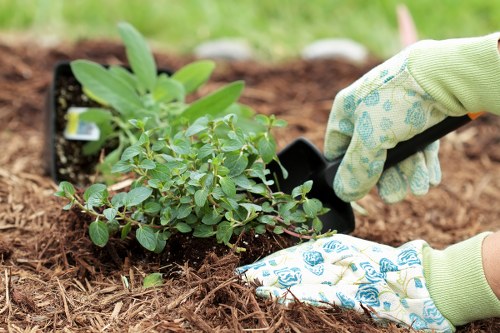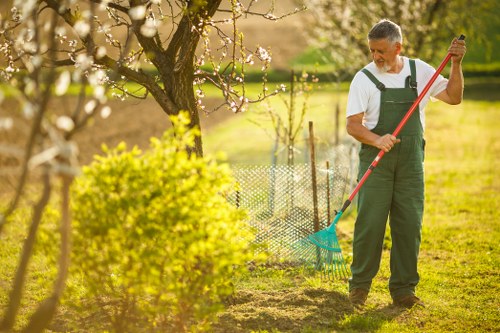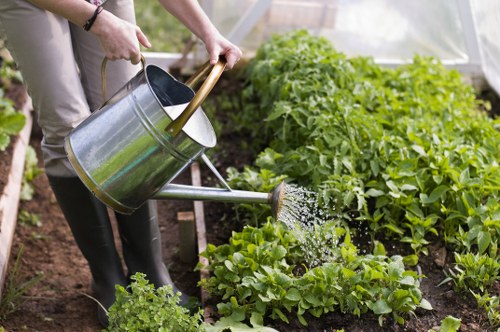Comprehensive Guide to Garden Maintenance in Temple
Introduction to Garden Maintenance

Maintaining a garden in a temple setting involves a unique blend of aesthetic appeal and spiritual significance. Gardens in temples are not just for beauty; they serve as sanctuaries for reflection, meditation, and community gatherings.
Proper garden maintenance ensures that these sacred spaces remain inviting and serene for visitors. It requires a thoughtful approach that respects both the natural environment and the cultural importance of the space.
In this article, we will explore essential practices, tips, and strategies for effective garden maintenance in temples, ensuring that these green spaces continue to inspire and nurture all who visit.
Understanding the Importance of Garden Maintenance

Gardens in temples play a crucial role in enhancing the spiritual atmosphere. They provide a tranquil environment where individuals can connect with nature and engage in contemplative practices.
Well-maintained gardens reflect the care and dedication of the temple community, fostering a sense of pride and ownership among its members. Additionally, they contribute to the overall sustainability of the temple by promoting biodiversity and ecological balance.
Neglecting garden maintenance can lead to overgrowth, pest infestations, and a decline in plant health, which not only diminishes the beauty of the temple but can also disrupt the spiritual harmony of the space.
Key Elements of Temple Garden Maintenance

Effective garden maintenance encompasses several key elements, each contributing to the overall health and appearance of the space.
- Plant Selection and Care: Choosing appropriate plants that thrive in the local climate and suit the temple’s aesthetic.
- Soil Management: Ensuring the soil is fertile and well-draining to support healthy plant growth.
- Watering Systems: Implementing efficient irrigation methods to maintain adequate moisture levels.
- Pest and Weed Control: Managing unwanted pests and invasive species to protect the garden's integrity.
- Pruning and Trimming: Regularly shaping plants to encourage healthy growth and maintain desired forms.
Addressing each of these elements with care and expertise is essential for creating a harmonious and vibrant temple garden.
Plant Selection for Temple Gardens

Choosing the right plants is fundamental to garden maintenance. Plants should be selected based on their suitability to the local climate, soil conditions, and the temple’s design theme.
Consider incorporating native species, as they are more likely to thrive and require less maintenance. Additionally, plants with seasonal blooms can provide year-round interest and beauty.
Here are some popular plant choices for temple gardens:
- Roses: Symbolizing purity and beauty, roses are a staple in many temple gardens.
- Lilies: Known for their elegant appearance and strong fragrance.
- Orchids: Adding an exotic touch with their unique shapes and colors.
- Ferns: Providing lush greenery and a soft texture to the garden landscape.
- Bamboo: Offering a sense of tranquility and natural elegance.
By carefully selecting plants that resonate with the temple’s spiritual ambiance, maintenance becomes more manageable and the garden more harmonious.
Soil Management and Fertilization

Healthy soil is the foundation of a thriving garden. Regular soil testing helps determine nutrient levels and pH, guiding appropriate fertilization practices.
Incorporate organic matter, such as compost, to enhance soil structure and fertility. Mulching can also help retain moisture, suppress weeds, and regulate soil temperature.
Here are some soil management tips:
- Conduct soil tests annually to monitor nutrient levels.
- Use organic fertilizers to promote sustainable growth.
- Implement crop rotation in vegetable gardens to prevent soil depletion.
- Ensure proper drainage to avoid waterlogging and root diseases.
- Regularly aerate the soil to enhance oxygen flow to the roots.
Maintaining healthy soil is critical for robust plant growth and reduces the need for excessive watering and chemical interventions.
Efficient Watering Systems

Watering is a crucial aspect of garden maintenance. An efficient irrigation system ensures that plants receive the right amount of water without wastage.
Drip irrigation and soaker hoses are excellent options for temple gardens as they deliver water directly to the plant roots, minimizing evaporation losses.
Key considerations for watering systems:
- Install timers to automate watering schedules.
- Use rainwater harvesting systems to conserve water.
- Regularly check and maintain irrigation equipment for optimal performance.
- Adjust watering frequencies based on seasonal changes and plant needs.
- Monitor soil moisture levels to prevent overwatering or underwatering.
By adopting efficient watering practices, temple gardens can thrive sustainably while conserving valuable water resources.
Pest and Weed Management

Maintaining a pest-free and weed-free garden is essential for plant health and aesthetic appeal.
Implement integrated pest management (IPM) strategies to address pest issues organically. This approach combines biological control, cultural practices, and minimal use of chemical pesticides.
Effective weed control methods include:
- Regularly removing weeds by hand or with appropriate tools.
- Applying mulch to suppress weed growth.
- Planting ground covers to outcompete weeds.
- Using pre-emergent herbicides cautiously to prevent unintended plant damage.
Promptly addressing pests and weeds maintains the garden’s beauty and supports the overall health of the ecosystem.
Pruning and Trimming Techniques

Regular pruning and trimming are vital for shaping plants, promoting healthy growth, and preventing diseases.
Different plants require specific pruning methods. Understanding the growth patterns and needs of each species ensures effective maintenance.
Best practices for pruning:
- Use clean, sharp tools to make precise cuts.
- Prune during the appropriate season to minimize stress on plants.
- Remove dead or diseased branches promptly.
- Maintain the desired shape and size through selective trimming.
- Encourage air circulation and light penetration by thinning dense foliage.
Proper pruning enhances the aesthetic value of the garden and supports the longevity of the plants.
Seasonal Garden Maintenance

Each season brings unique challenges and tasks for garden maintenance. Adapting practices to seasonal changes ensures year-round garden health.
Winter:
- Protect plants from frost by using covers or mulches.
- Prune dormant trees and shrubs.
- Plan for spring planting by ordering seeds and supplies.
Spring:
- Begin planting new flowers and vegetables.
- Apply fertilizers to support growth.
- Start regular watering and pest monitoring.
Summer:
- Maintain consistent watering schedules.
- Prune back overgrown plants.
- Manage pests and weeds diligently.
Autumn:
- Rake fallen leaves and compost them.
- Prepare soil for winter by adding organic matter.
- Plant bulbs for spring blooms.
By tailoring maintenance tasks to each season, temple gardens remain vibrant and resilient throughout the year.
Sustainable Gardening Practices

Embracing sustainable practices in garden maintenance promotes environmental stewardship and ensures long-term garden health.
Key sustainable methods include:
- Composting: Recycle organic waste into nutrient-rich compost to enhance soil fertility.
- Rainwater Harvesting: Collect and reuse rainwater for irrigation, reducing dependency on municipal water sources.
- Native Planting: Use native species that require less water and are more resistant to local pests.
- Organic Pest Control: Utilize natural predators and organic pesticides to manage pest populations.
- Mulching: Apply organic mulches to conserve moisture, suppress weeds, and improve soil health.
Implementing these practices not only benefits the environment but also creates a more resilient and self-sustaining garden ecosystem.
Tools and Equipment for Efficient Maintenance

Having the right tools and equipment is essential for effective garden maintenance. Investing in quality tools can make tasks easier and more efficient.
Essential gardening tools include:
- Pruning Shears: For precise cutting of branches and stems.
- Garden Fork: Useful for aerating soil and removing weeds.
- Watering Can or Hose: For delivering water to plants effectively.
- Trowel: Ideal for planting and transplanting small plants.
- Wheelbarrow: Facilitates the movement of soil, compost, and other materials.
Regular maintenance of tools, such as cleaning and sharpening, ensures their longevity and performance.
Landscaping Design Principles

A well-designed landscape enhances the beauty and functionality of a temple garden. Incorporating design principles ensures a balanced and harmonious layout.
Important design elements include:
- Symmetry: Creates a sense of order and balance.
- Focal Points: Feature elements like statues, fountains, or flowering plants that draw attention.
- Pathways: Guide visitors through the garden, facilitating exploration and reflection.
- Layering: Arrange plants at varying heights to add depth and interest.
- Color Coordination: Use complementary colors to create visually appealing combinations.
By adhering to these principles, garden maintenance becomes more intuitive, and the space remains inviting and spiritually uplifting.
Integrating Technology in Garden Maintenance

Modern technology can significantly enhance garden maintenance efficiency and effectiveness. Utilizing tools and innovations can streamline tasks and improve outcomes.
Technological advancements include:
- Irrigation Controllers: Automate watering schedules based on weather and soil moisture.
- Garden Management Software: Track plant health, maintenance schedules, and inventory.
- Smart Sensors: Monitor environmental conditions like temperature and humidity in real-time.
- Drones: Assist in surveying large garden areas for maintenance needs.
- LED Grow Lights: Support plant growth in shaded or indoor areas.
Incorporating these technologies can lead to more precise and resource-efficient maintenance practices, ensuring the garden remains vibrant and sustainable.
Staff Training and Community Involvement

Ensuring that garden maintenance is carried out effectively requires trained staff and active community involvement.
Staff training programs should focus on:
- Proper use and maintenance of gardening tools.
- Understanding plant care and identification of pests and diseases.
- Implementing sustainable gardening practices.
- Safety protocols for handling equipment and chemicals.
Encouraging community participation fosters a sense of ownership and responsibility. Regular workshops, volunteer days, and educational programs can engage members in the upkeep and beautification of the temple garden.
Budgeting for Garden Maintenance

Effective garden maintenance requires careful budgeting to cover tools, supplies, and labor costs. Creating a detailed maintenance budget helps in allocating resources efficiently.
Consider the following when budgeting:
- Cost of plants, seeds, and soil amendments.
- Investment in quality tools and equipment.
- Expenses for watering systems and irrigation repairs.
- Funds for pest and weed control measures.
- Labor costs for staff or contracted gardeners.
Additionally, incorporating cost-saving measures like composting and rainwater harvesting can reduce overall maintenance expenses while promoting sustainability.
Common Challenges in Garden Maintenance

Maintaining a temple garden comes with its set of challenges. Identifying and addressing these issues proactively ensures the garden remains healthy and beautiful.
Common challenges include:
- Pest Infestations: Invasive species can damage plants and disrupt the ecosystem.
- Water Management: Balancing adequate watering without overwatering can be tricky.
- Soil Degradation: Continuous use can lead to nutrient depletion and poor soil structure.
- Climate Extremes: Unpredictable weather patterns can stress plants.
- Labor Shortages: Ensuring sufficient manpower for maintenance tasks.
Implementing strategic planning and adaptive measures can help overcome these challenges effectively.
Best Practices for Long-Term Garden Health

Ensuring the long-term health of a temple garden requires consistent and thoughtful maintenance practices.
Adopt the following best practices:
- Regularly assess plant health and address issues promptly.
- Rotate crops and plants to prevent soil depletion.
- Maintain biodiversity to create a resilient ecosystem.
- Use organic fertilizers and pest controls to promote sustainability.
- Encourage community involvement for ongoing support.
By adhering to these practices, the temple garden will remain a thriving and welcoming space for generations to come.
Conclusion

Garden maintenance in temples is a vital task that enhances both the beauty and spiritual ambiance of the sacred space. By implementing effective maintenance strategies, from plant selection and soil management to sustainable practices and community involvement, temple gardens can flourish and continue to serve as serene sanctuaries for all who visit.
Embrace these guidelines to ensure that your temple garden remains a vibrant and nourishing environment, reflecting the harmony and tranquility that temples embody.
Ready to transform your temple garden? Contact us today to learn more about our professional garden maintenance services tailored to your needs.